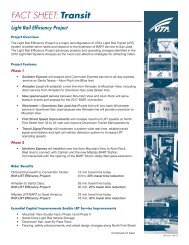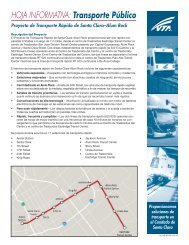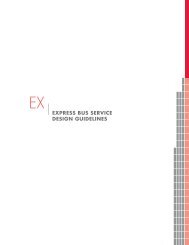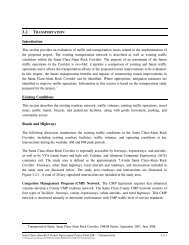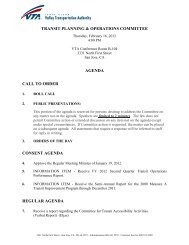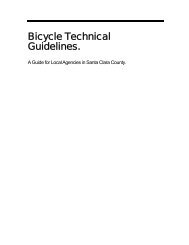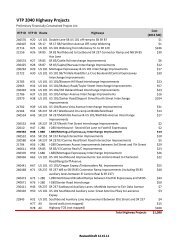Appendix I - Hazardous Materials Documentation - VTA
Appendix I - Hazardous Materials Documentation - VTA
Appendix I - Hazardous Materials Documentation - VTA
Create successful ePaper yourself
Turn your PDF publications into a flip-book with our unique Google optimized e-Paper software.
Contaminant Management Plan, SVRT/BART Extension<br />
• Unrestricted Off-site Reuse, in which soil and ballast excavated from the project can be reused in any<br />
off-site situation without restriction, including residential uses, or near a stream or shallow<br />
groundwater.<br />
• Unrestricted On-site Reuse, in which soil and ballast excavated from the project can be reused in any<br />
on-site area. This includes areas within a MPZ.<br />
• Stations and Facilities, in which soil and ballast excavated from the project can be reused in areas<br />
where there is anticipated to be relatively frequent potential exposure, like stations and maintenance<br />
facilities, but not within a MPZ.<br />
• Right-of-Way, in which soil and ballast excavated from the project can be reused in areas where there<br />
is anticipated to be relative infrequent potential exposure, like along the BART tracks and right-ofway,<br />
but not within a MPZ or areas which are part of a riparian fringe habitat.<br />
• Encapsulation, in which soil and ballast excavated from the project can be reused under barriers or<br />
other structures (and covered on all exposed sides by clean material). Encapsulations will not be<br />
placed within a MPZ or areas which are part of a riparian fringe habitat.<br />
Soil and ballast that contains chemical constituents at levels greater than the acceptable reuse concentrations<br />
for any of these five reuse scenarios will be disposed of off-site at an appropriate disposal facility in<br />
accordance with Section 4.4.<br />
4.2.3 Reuse Scenario Selection Process<br />
This section describes the process of classifying soil and ballast into one of the reuse scenarios listed in<br />
Section 4.2.2. In order to be eligible for a reuse scenario, a data population (Section 4.1.3.1) will have to meet<br />
the most restrictive of the reuse criteria for that scenario, as listed in subsequent sections. The reuse criteria<br />
are a combination of two types of values: 1) the site-specific risk assessment (SSRA) values for that chemical<br />
and exposure scenario (from Section 3), and 2) the screening values from existing regulatory agency<br />
guidance. For each reuse scenario, both SSRAs and regulatory agency screening values are developed<br />
specifically for that chemical and exposure scenario.<br />
In order to determine the reuse scenario in which a data population should be classified, the designer for each<br />
project segment will compare the EPCs (either 95 percent UCLs or maximum values, as described in Section<br />
4.1.3.3) to the SSRAs values and the screening values derived herein. Whichever is the least restrictive reuse<br />
scenario for which the data population satisfies all the requirements will be the classification received by that<br />
data population.<br />
4.2.4 Screening Values<br />
Screening values were obtained from a variety of sources, particularly existing regulatory agency screening<br />
values. Depending on the various exposure scenarios, separate screening values were selected for different<br />
101248 – July 2008 Page 34



